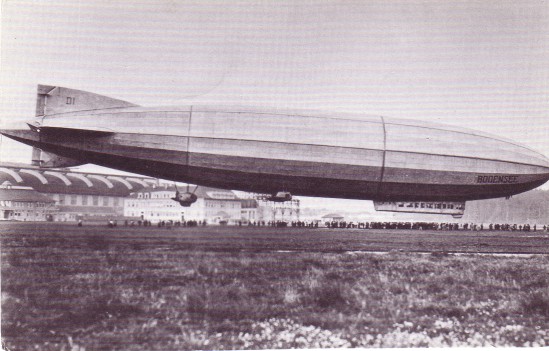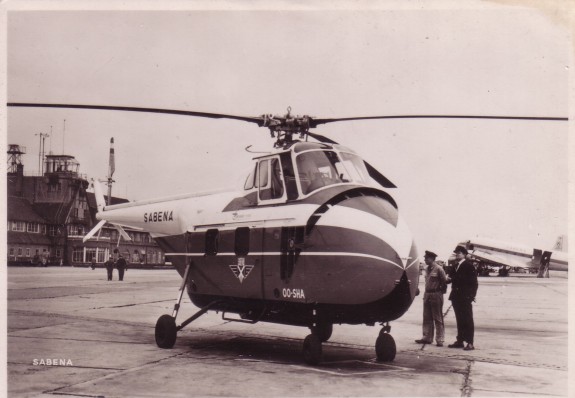WINGLESS AIRLINERS
 What’s the connection between a Zeppelin and a Belgian helicopter? Read on. Dealers Zeppelin postcard stocks tend to fall into three categories – quite numerous pre-1914 German issues, British anti-Zeppelin WW1 cards and, usually the highest priced, the inter-war Graf and Hindenburg cards. The card below, possibly a private photo card, found in a pile of ephemera seemed to fit none of these. It is too streamlined for pre WW1, appears to be civil and is too small for the inter-war monsters.
What’s the connection between a Zeppelin and a Belgian helicopter? Read on. Dealers Zeppelin postcard stocks tend to fall into three categories – quite numerous pre-1914 German issues, British anti-Zeppelin WW1 cards and, usually the highest priced, the inter-war Graf and Hindenburg cards. The card below, possibly a private photo card, found in a pile of ephemera seemed to fit none of these. It is too streamlined for pre WW1, appears to be civil and is too small for the inter-war monsters.
As usual with things European, the answer was in John Strouds 1960’s Putnam work “European Transport Aircraft since 1910”, now very rare as it was never re-printed. This confirms that this is the Delag passenger airship Bodensee of 1919. This is supported by comparison with the history card from the current Luftschiffbau Zeppelin.
 In 1918 the Airship airline Delag assumed that the post-war situation would be “business as usual” and commissioned the Bodensee for a revived Friedrichshafen-Berlin service. Bodensee flew on 20 August 1919 and entered service on this route 4 days later. The route operated both direct and via Munich and carried up to 27 passemgers, 20 in window-seats and one at the rear of the gondola plus six removable wicker chairs in the aisle. Further routes were planned to Switzerland, Italy, Spain and Stockholm. A second larger ship Nordstern was to operate the Swedish route but Bodensee did the proving flight. The service ended in December 1919 and Bodensee underwent lengthening by 10m to align it with Nordstern. However neither would fly again for Delag. The allies ruled that German civil aviation would not be permitted and both ships were to be taken as reparations. Nordstern did not fly until 1921 and then went to the French Navy who used it up to 1926 as the Mediterranee. Bodensee was flown to Rome, also in 1921 and handed over to the Italian Navy as Esperia. It too was scrapped in 1927.
In 1918 the Airship airline Delag assumed that the post-war situation would be “business as usual” and commissioned the Bodensee for a revived Friedrichshafen-Berlin service. Bodensee flew on 20 August 1919 and entered service on this route 4 days later. The route operated both direct and via Munich and carried up to 27 passemgers, 20 in window-seats and one at the rear of the gondola plus six removable wicker chairs in the aisle. Further routes were planned to Switzerland, Italy, Spain and Stockholm. A second larger ship Nordstern was to operate the Swedish route but Bodensee did the proving flight. The service ended in December 1919 and Bodensee underwent lengthening by 10m to align it with Nordstern. However neither would fly again for Delag. The allies ruled that German civil aviation would not be permitted and both ships were to be taken as reparations. Nordstern did not fly until 1921 and then went to the French Navy who used it up to 1926 as the Mediterranee. Bodensee was flown to Rome, also in 1921 and handed over to the Italian Navy as Esperia. It too was scrapped in 1927.
All this is from John Stroud’s book. The next “second glance” concerns the back of this SABENA CV-240 card from their superb 1950s set of continental-size photo cards. Note the BEA Viking tail behind.
 The back message is actually written by John Stroud to his wife and is headed “Brussels Hotel Cecil 0223 31/8/53”. The non-personal part of the message goes as follows.
The back message is actually written by John Stroud to his wife and is headed “Brussels Hotel Cecil 0223 31/8/53”. The non-personal part of the message goes as follows.
“ Have just got into bed. Flew here in DC-4 OO-CBD, 58 minutes airborne. It was a beautiful night with moon and stars. I already have a helicopter timetable !!! I have put in a call for 0615 and will be there to see the mail helicopter take-off at 0715 – then breakfast”. Then, added below the signature “Went at 0700 to see mail service – it did not operate”.
 This would actually have not been the first SABENA helicopter mail, which had been operated experimentally with Bell 47s since 1950. The next day September 1, did in fact see the inauguration of the first international scheduled helicopter service linking Brussels with Lille, Maastricht and Rotterdam. Many cards would subsequently be produced of the heliports served with the possible exception of Lille. The equipment was the Sikorsky S55, which in turn appeared in the real-photo SABENA card series.
This would actually have not been the first SABENA helicopter mail, which had been operated experimentally with Bell 47s since 1950. The next day September 1, did in fact see the inauguration of the first international scheduled helicopter service linking Brussels with Lille, Maastricht and Rotterdam. Many cards would subsequently be produced of the heliports served with the possible exception of Lille. The equipment was the Sikorsky S55, which in turn appeared in the real-photo SABENA card series.
The location is the Brussels Airport at Melsbroek which was where the current freight/military side of Zaventem is. Note the Prestwick–style tower on top of a pitched roof.
The service continued until 1966, with the Sikorsky S58 being used later.
Other destinations added were Cologne, Bonn, Dortmund, Duisburg, Eindhoven and Paris. The service was never profitable and was rendered obsolete by improved ground transport .

 What’s the connection between a Zeppelin and a Belgian helicopter? Read on. Dealers Zeppelin postcard stocks tend to fall into three categories – quite numerous pre-1914 German issues, British anti-Zeppelin WW1 cards and, usually the highest priced, the inter-war Graf and Hindenburg cards. The card below, possibly a private photo card, found in a pile of ephemera seemed to fit none of these. It is too streamlined for pre WW1, appears to be civil and is too small for the inter-war monsters.
What’s the connection between a Zeppelin and a Belgian helicopter? Read on. Dealers Zeppelin postcard stocks tend to fall into three categories – quite numerous pre-1914 German issues, British anti-Zeppelin WW1 cards and, usually the highest priced, the inter-war Graf and Hindenburg cards. The card below, possibly a private photo card, found in a pile of ephemera seemed to fit none of these. It is too streamlined for pre WW1, appears to be civil and is too small for the inter-war monsters.
 In 1918 the Airship airline Delag assumed that the post-war situation would be “business as usual” and commissioned the Bodensee for a revived Friedrichshafen-Berlin service. Bodensee flew on 20 August 1919 and entered service on this route 4 days later. The route operated both direct and via Munich and carried up to 27 passemgers, 20 in window-seats and one at the rear of the gondola plus six removable wicker chairs in the aisle. Further routes were planned to Switzerland, Italy, Spain and Stockholm. A second larger ship Nordstern was to operate the Swedish route but Bodensee did the proving flight. The service ended in December 1919 and Bodensee underwent lengthening by 10m to align it with Nordstern. However neither would fly again for Delag. The allies ruled that German civil aviation would not be permitted and both ships were to be taken as reparations. Nordstern did not fly until 1921 and then went to the French Navy who used it up to 1926 as the Mediterranee. Bodensee was flown to Rome, also in 1921 and handed over to the Italian Navy as Esperia. It too was scrapped in 1927.
In 1918 the Airship airline Delag assumed that the post-war situation would be “business as usual” and commissioned the Bodensee for a revived Friedrichshafen-Berlin service. Bodensee flew on 20 August 1919 and entered service on this route 4 days later. The route operated both direct and via Munich and carried up to 27 passemgers, 20 in window-seats and one at the rear of the gondola plus six removable wicker chairs in the aisle. Further routes were planned to Switzerland, Italy, Spain and Stockholm. A second larger ship Nordstern was to operate the Swedish route but Bodensee did the proving flight. The service ended in December 1919 and Bodensee underwent lengthening by 10m to align it with Nordstern. However neither would fly again for Delag. The allies ruled that German civil aviation would not be permitted and both ships were to be taken as reparations. Nordstern did not fly until 1921 and then went to the French Navy who used it up to 1926 as the Mediterranee. Bodensee was flown to Rome, also in 1921 and handed over to the Italian Navy as Esperia. It too was scrapped in 1927.
 The back message is actually written by John Stroud to his wife and is headed “Brussels Hotel Cecil 0223 31/8/53”. The non-personal part of the message goes as follows.
The back message is actually written by John Stroud to his wife and is headed “Brussels Hotel Cecil 0223 31/8/53”. The non-personal part of the message goes as follows.
 This would actually have not been the first SABENA helicopter mail, which had been operated experimentally with Bell 47s since 1950. The next day September 1, did in fact see the inauguration of the first international scheduled helicopter service linking Brussels with Lille, Maastricht and Rotterdam. Many cards would subsequently be produced of the heliports served with the possible exception of Lille. The equipment was the Sikorsky S55, which in turn appeared in the real-photo SABENA card series.
This would actually have not been the first SABENA helicopter mail, which had been operated experimentally with Bell 47s since 1950. The next day September 1, did in fact see the inauguration of the first international scheduled helicopter service linking Brussels with Lille, Maastricht and Rotterdam. Many cards would subsequently be produced of the heliports served with the possible exception of Lille. The equipment was the Sikorsky S55, which in turn appeared in the real-photo SABENA card series.